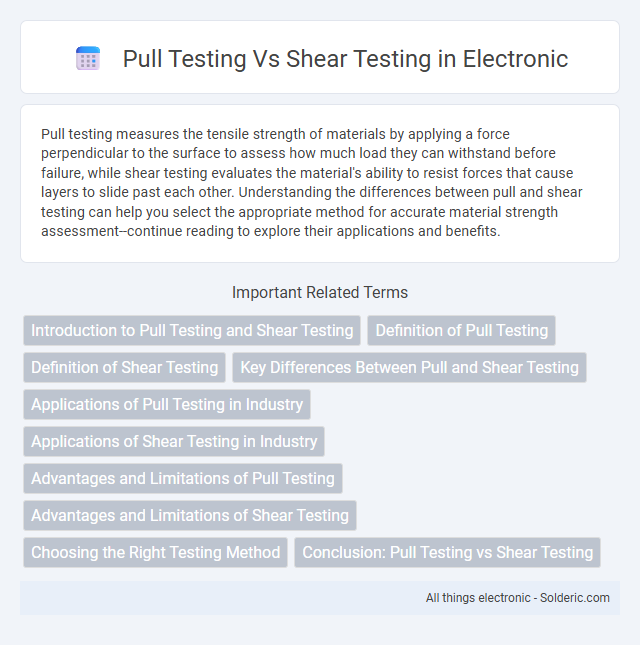Pull testing measures the tensile strength of materials by applying a force perpendicular to the surface to assess how much load they can withstand before failure, while shear testing evaluates the material's ability to resist forces that cause layers to slide past each other. Understanding the differences between pull and shear testing can help you select the appropriate method for accurate material strength assessment--continue reading to explore their applications and benefits.
Comparison Table
| Aspect | Pull Testing | Shear Testing |
|---|---|---|
| Definition | Measures tensile strength by pulling a material until failure | Measures shear strength by applying force parallel to the surface |
| Purpose | Evaluates adhesion, bond strength, and tensile load capacity | Assesses resistance to sliding or shearing forces |
| Common Applications | Fasteners, adhesive bonds, cable strength testing | Welds, rivets, lap joints, and layered materials |
| Force Direction | Perpendicular to the surface (tensile) | Parallel to the surface (shear) |
| Failure Mode | Material or bond separation due to tension | Material or bond failure by sliding or shearing |
| Measurement Units | Newton (N), Pounds-force (lbf) | Newton (N), Pounds-force (lbf) |
| Test Standards | ASTM D4541, ISO 4624 | ASTM D1002, ISO 14272 |
| Equipment | Tensile testing machines, pull testers | Shear testing machines, lap shear fixtures |
Introduction to Pull Testing and Shear Testing
Pull testing measures the tensile strength of materials by applying force until the sample breaks or deforms, commonly used to evaluate adhesive bonds, coatings, and fasteners. Shear testing assesses the material's ability to withstand forces applied parallel to its surface, critical for analyzing joints, welds, and structural components under shear stress. Both testing methods ensure product reliability and safety by simulating real-world mechanical stress conditions specific to different material applications.
Definition of Pull Testing
Pull testing measures the tensile strength of materials by applying a pulling force until failure occurs, evaluating adhesion, bonding, or tensile properties. This method is essential in industries like manufacturing and construction to ensure material integrity and safety under tension. Your quality control processes can benefit from accurate pull testing results, providing reliable data on material performance.
Definition of Shear Testing
Shear testing evaluates the ability of materials or components to resist forces that cause parts to slide past each other along a plane. This method measures shear strength by applying parallel opposing forces until the specimen fails, revealing critical data on material durability and joint integrity. Your choice between pull testing and shear testing depends on whether you need to assess tensile strength or resistance to sliding forces.
Key Differences Between Pull and Shear Testing
Pull testing measures the tensile strength of a material by applying force perpendicular to its surface until it breaks, while shear testing evaluates the material's ability to resist forces applied parallel to its surface. The key difference lies in the direction of the applied force: pull tests assess how well your material holds under stretching or pulling stress, whereas shear tests focus on the material's resistance to sliding or cutting forces. Understanding these distinctions helps you select the appropriate test method for evaluating material performance and structural integrity.
Applications of Pull Testing in Industry
Pull testing is widely applied in industries such as construction, aerospace, and electronics to evaluate the tensile strength and adhesion quality of materials and components. It ensures the reliability of fasteners, coatings, adhesives, and welds under tensile stress, preventing structural failure. Industries also use pull testing for quality control in manufacturing processes, verifying compliance with safety and performance standards.
Applications of Shear Testing in Industry
Shear testing is widely used across industries to evaluate material strength and adhesion properties, especially in manufacturing, construction, and packaging sectors. It determines the resistance of materials to forces that cause sliding failures, critical for quality control in adhesive bonding, welds, and fasteners. Your products' performance reliability can be ensured through precise shear testing, preventing potential structural failures in practical applications.
Advantages and Limitations of Pull Testing
Pull testing offers precise measurement of tensile strength, ensuring the durability and reliability of materials under tension. Its advantage lies in detecting weaknesses before product failure, providing valuable data for quality control. However, pull testing can be limited by sample size restrictions and may not fully represent complex real-world stress conditions.
Advantages and Limitations of Shear Testing
Shear testing offers the advantage of directly measuring the shear strength of materials, providing critical data for applications where components experience lateral forces. It is particularly effective for evaluating adhesives, welds, and bonded joints, ensuring reliability under shear stress conditions. However, shear testing can be limited by specimen geometry sensitivity and may not fully represent complex real-world load scenarios, potentially affecting the accuracy of your material performance predictions.
Choosing the Right Testing Method
Choosing the right testing method depends on the specific application and the type of force your materials or components will face in real conditions. Pull testing is ideal for evaluating tensile strength and adhesive bonding by applying force perpendicular to the surface, while shear testing measures the material's resistance to sliding forces parallel to the bonded surfaces. Understanding the mechanical stress your product endures helps determine whether pull or shear testing will provide the most accurate assessment of durability and performance.
Conclusion: Pull Testing vs Shear Testing
Pull testing measures the tensile strength of materials by applying force perpendicular to the surface, while shear testing evaluates the material's ability to resist forces applied parallel to the surface. Your choice between pull testing and shear testing depends on the specific mechanical stress your material or component will encounter in its application. Both methods provide critical data for quality control and material performance but target different failure modes essential for optimized product durability.
Pull testing vs shear testing Infographic

 solderic.com
solderic.com